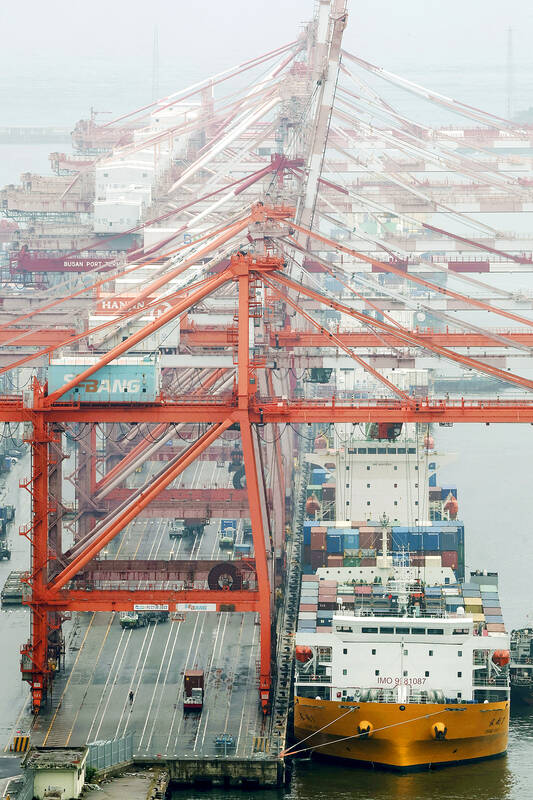South Korean exports offered an early sign of improvement in global trade after their first year-on-year gain since last summer.
Preliminary trade data showed a 5.3 percent gain in exports in the first 20 days of this month from a year earlier for the first increase since August last year, a possible sign that a slowdown in world demand is starting to ease.
The rise was largely driven by gains in auto and shipping-related exports, while semiconductor exports continued to drop.

Photo: EPA-EFE
As a key provider of chips and smartphones for the global economy, South Korea’s export data offer one of the earliest pulse checks on the strength of international trade and tech-sector demand.
While the figures were encouraging, it is too early to gauge how fast any recovery might be, Australia and New Zealand Banking Group economist Krystal Tan (譚恩) said.
“But it does look like we’re nearing a bottom,” Tan said.
An improvement in the nation’s shipments can be a leading indicator for the wider trend, although economists warn against drawing concrete conclusions from an incomplete set of monthly figures.
“The data indicates global trade may have bottomed out, but whether it is set for a full-on recovery will be something to be watched,” said Moon Jung-hiu, economist at KB Kookmin Bank in Seoul.
Gains were led largely by shipments to the US, steady demand for automobiles and a jump in shipping-related demand.
Exports to the EU and Hong Kong also advanced on a year-on-year basis, although shipments to China were down again.
The results fit in with a picture of a US economy showing resilience, despite a string of rate hikes, while China’s recovery continues to disappoint even as policymakers there ramp up stimulus to try and restore momentum.
A full recovery in global trade depends largely on China — a major engine of the world economy — and a resurgence in appetite for chips, which go into everything from vehicles to electronic devices.
The figures have to be taken “with a grain of salt and can be seen as US exports stabilizing rather than a surge,” Tan said.
Even with the gain, overall exports were still about 18 percent lower from their 20-day peak in March last year.
A measure of average daily exports, which removes potential distortions from changes in the number of working days, also showed that shipments were not as strong as the headline figure indicated.
The average inched down 2 percent, although that was the smallest fall since exports began to drop last year.
The 20-day data showed that auto exports more than doubled. Shipping-related demand, a factor that sometimes skews monthly figures, was also up by more than 100 percent.
While semiconductor exports fell 23.5 percent, the drop eased compared with last month’s full month figures.
Overall imports declined 11.2 percent, resulting in a trade deficit of US$1.61 billion.

GROWING OWINGS: While Luxembourg and China swapped the top three spots, the US continued to be the largest exposure for Taiwan for the 41st consecutive quarter The US remained the largest debtor nation to Taiwan’s banking sector for the 41st consecutive quarter at the end of September, after local banks’ exposure to the US market rose more than 2 percent from three months earlier, the central bank said. Exposure to the US increased to US$198.896 billion, up US$4.026 billion, or 2.07 percent, from US$194.87 billion in the previous quarter, data released by the central bank showed on Friday. Of the increase, about US$1.4 billion came from banks’ investments in securitized products and interbank loans in the US, while another US$2.6 billion stemmed from trust assets, including mutual funds,

Micron Memory Taiwan Co (台灣美光), a subsidiary of US memorychip maker Micron Technology Inc, has been granted a NT$4.7 billion (US$149.5 million) subsidy under the Ministry of Economic Affairs A+ Corporate Innovation and R&D Enhancement program, the ministry said yesterday. The US memorychip maker’s program aims to back the development of high-performance and high-bandwidth memory chips with a total budget of NT$11.75 billion, the ministry said. Aside from the government funding, Micron is to inject the remaining investment of NT$7.06 billion as the company applied to participate the government’s Global Innovation Partnership Program to deepen technology cooperation, a ministry official told the

AI TALENT: No financial details were released about the deal, in which top Groq executives, including its CEO, would join Nvidia to help advance the technology Nvidia Corp has agreed to a licensing deal with artificial intelligence (AI) start-up Groq, furthering its investments in companies connected to the AI boom and gaining the right to add a new type of technology to its products. The world’s largest publicly traded company has paid for the right to use Groq’s technology and is to integrate its chip design into future products. Some of the start-up’s executives are leaving to join Nvidia to help with that effort, the companies said. Groq would continue as an independent company with a new chief executive, it said on Wednesday in a post on its Web

Taiwan Semiconductor Manufacturing Co (TSMC, 台積電), the world’s leading advanced chipmaker, officially began volume production of its 2-nanometer chips in the fourth quarter of this year, according to a recent update on the company’s Web site. The low-key announcement confirms that TSMC, the go-to chipmaker for artificial intelligence (AI) hardware providers Nvidia Corp and iPhone maker Apple Inc, met its original roadmap for the next-generation technology. Production is currently centered at Fab 22 in Kaohsiung, utilizing the company’s first-generation nanosheet transistor technology. The new architecture achieves “full-node strides in performance and power consumption,” TSMC said. The company described the 2nm process as